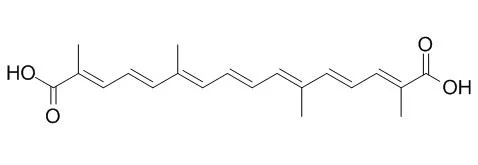| In vitro: |
| Molecules . 2017 Dec 23;23(1):30. | | Saffron: An Old Medicinal Plant and a Potential Novel Functional Food[Pubmed: 29295497] | | Abstract
The spice saffron is made from the dried stigmas of the plant Crocus sativus L. The main use of saffron is in cooking, due to its ability to impart colour, flavour and aroma to foods and beverages. However, from time immemorial it has also been considered a medicinal plant because it possesses therapeutic properties, as illustrated in paintings found on the island of Santorini, dated 1627 BC. It is included in Catalogues of Medicinal Plants and in the European Pharmacopoeias, being part of a great number of compounded formulas from the 16th to the 20th centuries. The medicinal and pharmaceutical uses of this plant largely disappeared with the advent of synthetic chemistry-produced drugs. However, in recent years there has been growing interest in demonstrating saffron's already known bioactivity, which is attributed to the main components-crocetin and its glycosidic esters, called crocins, and safranal-and to the synergy between the compounds present in the spice. The objective of this work was to provide an updated and critical review of the research on the therapeutic properties of saffron, including activity on the nervous and cardiovascular systems, in the liver, its antidepressant, anxiolytic and antineoplastic properties, as well as its potential use as a functional food or nutraceutical.
Keywords: crocetin esters; crocin; functional food; nutraceutical; picrocrocin; saffron; safranal; therapeutic properties. | | Phytomedicine . 2015 Jan 15;22(1):36-44. | | Intestinal formation of trans-crocetin from saffron extract (Crocus sativus L.) and in vitro permeation through intestinal and blood brain barrier[Pubmed: 25636868] | | Abstract
Aims: Extracts of saffron (Crocus sativus L.) have traditionally been used against depressions. Recent preclinical and clinical investigations have rationalized this traditional use. Trans-crocetin, a saffron metabolite originating from the crocin apocarotenoids, has been shown to exert strong NMDA receptor affinity and is thought to be responsible for the CNS activity of saffron. Pharmacokinetic properties of the main constituents from saffron have only been described to a limited extent. Therefore the present in vitro study aimed to determine if crocin-1 and trans-crocetin are able to pass the intestinal barrier and to penetrate the blood brain barrier (BBB). Additionally, the intestinal conversion of glycosylated crocins to the lipophilic crocetin had to be investigated. Experiments with Caco-2 cells and two different porcine BBB systems were conducted. Further on, potential intestinal metabolism of saffron extract was investigated by ex vivo experiments with murine intestine.
Methodology: In vitro Caco-2 monolayer cell culture was used for investigation of intestinal permeation of crocin-1 and trans-crocetin. In vitro models of porcine brain capillary endothelial cells (BCEC) and blood cerebrospinal fluid barrier (BCSFB) were used for monitoring permeation characteristics of trans-crocetin through the blood brain barrier (BBB). Intestine tissue and feces homogenates from mice served for metabolism experiments.
Results: Crocin-1, even at high concentrations (1000 μM) does not penetrate Caco-2 monolayers in relevant amounts. In contrast, trans-crocetin permeates in a concentration-independent manner (10-114 μM) the intestinal barrier by transcellular passage with about 32% of the substrate being transported within 2 h and a permeation coefficient of Papp 25.7 × 10(-)(6) ± 6.23 × 10(-)(6) cm/s. Trans-crocetin serves as substrate for pGP efflux pump. Trans-crocetin permeates BBB with a slow but constant velocity over a 29 h period (BCEC system: Papp 1.48 × 10(-)(6) ± 0.12 × 10(-)(6) cm/s; BCSFB system Papp 3.85 × 10(-)(6) ± 0.21 × 10(-)(6) cm/s). Conversion of glycosylated crocins from saffron extract to trans-crocetin occurs mainly by intestinal cells, rather than by microbiological fermentation in the colon.
Conclusion: The here described in vitro studies have shown that crocins from saffron are probably not bioavailable in the systemic compartment after oral application. On the other side the investigations clearly have pointed out that crocins get hydrolyzed in the intestine to the deglycosylated trans-crocetin, which subsequently is absorbed by passive transcellular diffusion to a high extend and within a short time interval over the intestinal barrier. Crocetin will penetrate in a quite slow process the blood brain barrier to reach the CNS. The intestinal deglycosylation of different crocins in the intestine is mainly due to enzymatic processes in the epithelial cells and only to a very minor extent due to deglycosylation by the fecal microbiome. On the other side the fecal bacteria degrade the apocarotenoid backbone to smaller alkyl units, which do not show any more the typical UV absorbance of crocins. As previous studies have shown strong NMDA receptor affinity and channel opening activity of trans-crocetin the use of saffron for CNS disorders seems to be justified from the pharmacokinetic and pharmacodynamic background.
Keywords: Absorption; Blood brain barrier; Caco-2; Crocetin; Crocus sativus L.; Metabolism. |
|






 Cell. 2018 Jan 11;172(1-2):249-261.e12. doi: 10.1016/j.cell.2017.12.019.IF=36.216(2019)
Cell. 2018 Jan 11;172(1-2):249-261.e12. doi: 10.1016/j.cell.2017.12.019.IF=36.216(2019) Cell Metab. 2020 Mar 3;31(3):534-548.e5. doi: 10.1016/j.cmet.2020.01.002.IF=22.415(2019)
Cell Metab. 2020 Mar 3;31(3):534-548.e5. doi: 10.1016/j.cmet.2020.01.002.IF=22.415(2019) Mol Cell. 2017 Nov 16;68(4):673-685.e6. doi: 10.1016/j.molcel.2017.10.022.IF=14.548(2019)
Mol Cell. 2017 Nov 16;68(4):673-685.e6. doi: 10.1016/j.molcel.2017.10.022.IF=14.548(2019)